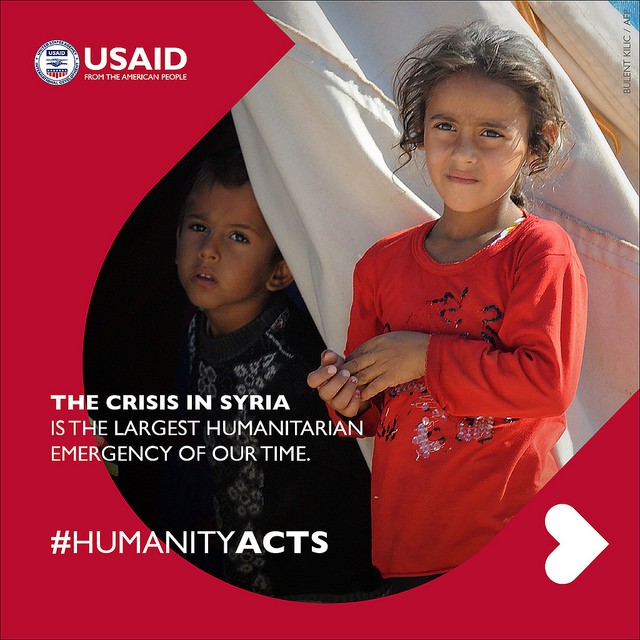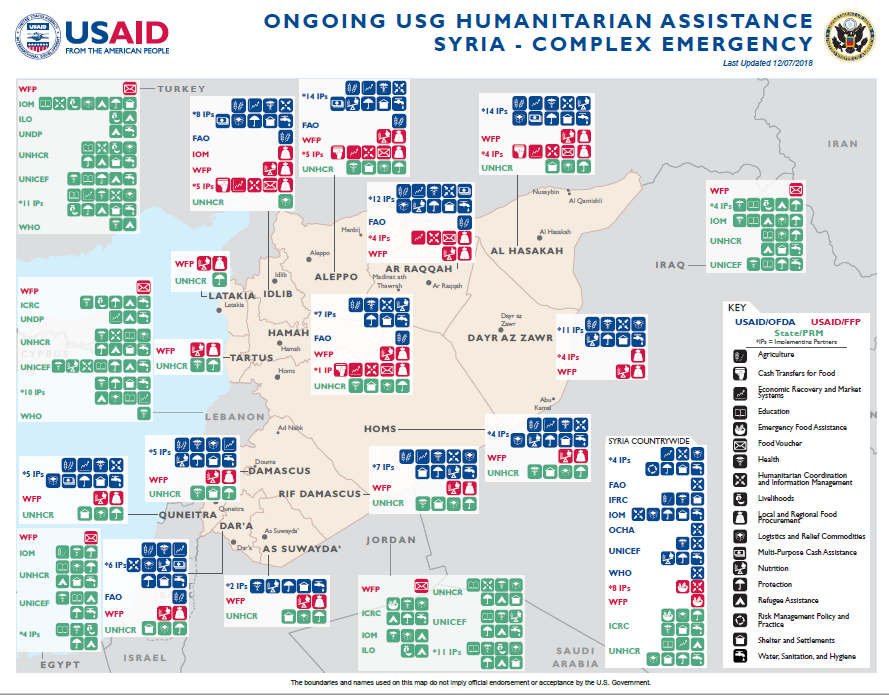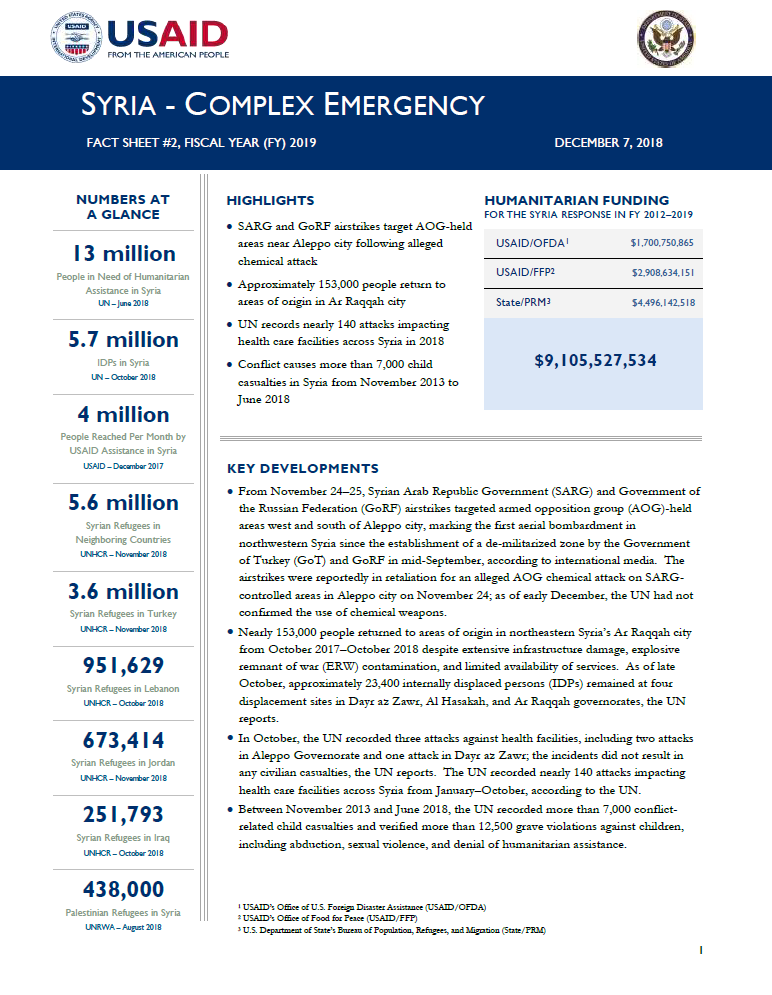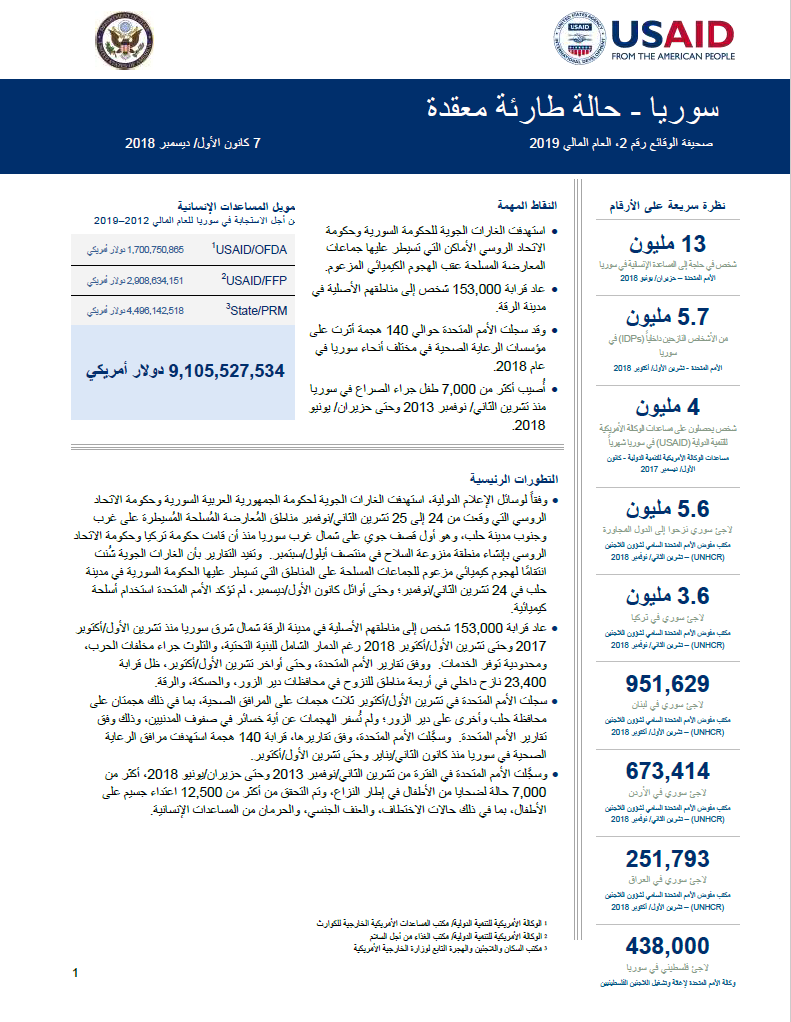- What We Do
- Agriculture and Food Security
- Democracy, Human Rights and Governance
- Economic Growth and Trade
- Education
- Environment and Global Climate Change
- Gender Equality and Women's Empowerment
- Global Health
- Humanitarian Assistance
- Transformation at USAID
- Water and Sanitation
- Working in Crises and Conflict
- U.S. Global Development Lab
Speeches Shim
December 07, 2018
Highlights
SARG and GoRF airstrikes target AOG-held areas near Aleppo city following alleged chemical attack
Approximately 153,000 people return to areas of origin in Ar Raqqah city
UN records nearly 140 attacks impacting health care facilities across Syria in 2018
Conflict causes more than 7,000 child casualties in Syria from November 2013 to June 2018
Key Developments
From November 24–25, Syrian Arab Republic Government (SARG) and Government of the Russian Federation (GoRF) airstrikes targeted armed opposition group (AOG)-held areas west and south of Aleppo city, marking the first aerial bombardment in northwestern Syria since the establishment of a de-militarized zone by the Government of Turkey (GoT) and GoRF in mid-September, according to international media. The airstrikes were reportedly in retaliation for an alleged AOG chemical attack on SARGcontrolled areas in Aleppo city on November 24; as of early December, the UN had not confirmed the use of chemical weapons.
Nearly 153,000 people returned to areas of origin in northeastern Syria’s Ar Raqqah city from October 2017–October 2018 despite extensive infrastructure damage, explosive remnant of war (ERW) contamination, and limited availability of services. As of late October, approximately 23,400 internally displaced persons (IDPs) remained at four displacement sites in Dayr az Zawr, Al Hasakah, and Ar Raqqah governorates, the UN reports.
In October, the UN recorded three attacks against health facilities, including two attacks in Aleppo Governorate and one attack in Dayr az Zawr; the incidents did not result in any civilian casualties, the UN reports. The UN recorded nearly 140 attacks impacting health care facilities across Syria from January–October, according to the UN.
Between November 2013 and June 2018, the UN recorded more than 7,000 conflictrelated child casualties and verified more than 12,500 grave violations against children, including abduction, sexual violence, and denial of humanitarian assistance.
Syria Complex Emergency - Map #2 FY19 ![]() (pdf - 457k)
(pdf - 457k)
Numbers At A Glance
13 million
5.7 million
4 million
5.6 million
3.6 million
951,629
673,414
251,793
438,000
Humanitarian Funding
To Syria Humanitarian Response
FY 2012 - FY 2018
| USAID/OFDA | $1,700,750,865 |
| USAID/FFP | $2,908,634,151 |
| State/PRM | $4,496,142,518 |
| TOTAL | $9,105,527,534 |
Syria Complex Emergency - Fact Sheet #2 FY19 ![]() (pdf - 189k)
(pdf - 189k)
سوريا - حالة طارئة معقدة ![]() (pdf - 341k)
(pdf - 341k)
INSECURITY, DISPLACEMENT, AND HUMANITARIAN ACCESS
Conflict in Syria killed at least 230 civilians during November, including at least 70 deaths due to SARG and GoRF military operations, according to the Syria Network for Human Rights (SNHR). To date in 2018, SNHR has recorded nearly 6,630 civilian deaths in Syria.
Between November 2013 and June 2018, the UN recorded more than 7,000 conflict-related child causalities, approximately 60 percent of which were due to airstrikes, according to a November UN report on children in armed conflict in Syria. The UN also recorded more than 12,500 grave violations against children—including abduction, sexual violence, and denial of humanitarian assistance—and the recruitment of more than 3,300 children by armed groups during the reporting period. The UN noted that access constraints had hindered data collection and that figures were likely higher. On November 27, UN Regional Humanitarian Coordinator for Syria Panos Moumtzis issued a statement advocating for the protection of civilians and civilian infrastructure and calling on all parties to adhere to international conventions pertaining to children in armed conflict.
Northeastern Syria
Conflict between the Islamic State of Iraq and Syria (ISIS) and Syrian Democratic Forces (SDF) in southern Dayr az Zawr displaced approximately 27,000 people from June–October, the UN reports. Relief agencies continue to report restrictions on civilian movements in the governorate’s Hajin sub-district—where an estimated 10,000 civilians remain trapped in ISIS-controlled areas—and neighboring Basira, Sur, Susat, and Thiban sub-districts, with many individuals utilizing informal routes and reportedly paying large sums to reach SDF-controlled areas, according to the UN. Insecurity also continues to hinder UN agencies and non-governmental organizations (NGOs) from accessing areas near the frontlines, including IDP sites, the UN reports. Despite access constraints, two UN partners provided multisector assistance—including food, nutrition, and water, sanitation, and hygiene (WASH) items—to approximately 5,000 IDPs in Hajin in October.
Displaced populations continue to return to areas of origin in Ar Raqqah city despite high levels of infrastructure damage and ERW contamination, as well as limited service availability in areas of displacement. From October 2017–October 2018, nearly 153,000 people returned to Ar Raqqah city, the UN reports. Surveyed returnees reported the absence of basic services, lack of employment opportunities, and insecurity in areas of displacement as primary reasons for returning to areas of origin in northeastern Syria, according to a July and August assessment.
In October, the UN reported that interference by local authorities disrupted health and nutrition programming in Al Hasakah and Ar Raqqah. On October 24, the Kurdish Self-Administration closed four primary health care centers and an immunizations service center supported by U.S. Government (USG) partners the UN Children’s Fund (UNICEF) and UN World Health Organization (WHO) in Al Hasakah and Ar Raqqah, the UN reports. Officials also closed several health and nutrition clinics in Ar Raqqah city. The UN and relief partners continue to advocate independent humanitarian activities and increased access to vulnerable populations.
Northwestern Syria
SARG and GoRF airstrikes targeted AOG-held areas near Aleppo city from November 24–25, representing the first instance of aerial bombardment in northwestern Syria since the GoT–GoRF de-militarized zone was established in mid-September, international media report. The airstrikes were reportedly in retaliation for an alleged AOG chemical attack on SARG-controlled areas in Aleppo city on November 24, which resulted in an unconfirmed number of civilian injuries, media reports. As of early December, the UN had not confirmed the use of chemical weapons.
FOOD SECURITY AND NUTRITION
Relief agencies remain concerned regarding drought conditions in northeastern Syria. Farmers in Al Hasakah—where 45 percent of Syria’s wheat is cultivated—reported low crop yields in the most recent harvest season due to a combination of poor growing conditions, including delayed rains, an extended dry period, and late heavy rainfall, according to a USAID partner post-harvest survey. Nearly all interviewed farmers were unable to generate income from the harvest, and reported that low harvest yields were insufficient to fulfill household consumption needs until the next harvest season, resulting in negative coping strategies, including borrowing or purchasing food on credit, borrowing money to cover basic needs, and reducing expenditures on essential non-food items such as education, health care, and medicine. All interviewed farmers anticipate increasing food prices and limited availability of bread, legumes, meat, and vegetables in local markets. Farmers harvested 1.1 million metric tons (MT) of wheat in Al Hasakah, representing a 70 percent decrease from the pre-crisis average yield of 3.7 million MT, the UN reports.
The percentage of Syrian households reporting inadequate food consumption levels—indicating limited access to a sufficient diversity and quantity of food—increased from 26 percent in September to 29 percent in October, with poor food consumption levels increasing by approximately 7 percent in UN-designated hard-to-reach (HTR) areas in Aleppo, Hamah, and Homs governorates, according to a UN World Food Program (WFP) report. Among surveyed governorates, Tartus Governorate maintained the highest percentage of households—approximately 36 percent—with inadequate food consumption levels due to increasing food prices. In addition, approximately 40 percent of femaleheaded households countrywide reported inadequate food consumption levels; female-headed households also reported utilizing the highest number of negative coping strategies—including borrowing food, limiting portion size, and reducing the number of meals consumed—to meet food needs, WFP reports. In total, approximately 80 percent of households in Syria reported utilizing at least one negative coping strategy in October, with the highest number of negative coping strategies reported in Dar’a, Hamah, and Homs governorates.
USAID/FFP partner WFP provided emergency food assistance to approximately 3.2 million people in all of Syria’s 14 governorates in October, including nearly 292,000 people in approximately 60 HTR areas in Aleppo, Dar’a, Dayr az Zawr, Quneitra, Ar Raqqah, and Rif Damascus governorates. In addition, WFP is implementing seven livelihood assistance projects—including farming support, food processing, and vocational training—benefiting more than 66,200 people across 11 governorates.
In October, WFP provided nutrition supplies for the prevention of acute malnutrition for nearly 118,000 children in 13 governorates. WFP also delivered nutrition supplies for the treatment of moderate acute malnutrition to nutrition centers and mobile clinics in Aleppo, sufficient to treat more than 3,050 individuals for one month.
UNICEF screened approximately 120,000 children and pregnant and lactating women for acute malnutrition in October, identifying and treating nearly 660 children experiencing severe acute malnutrition. UNICEF also provided approximately 73,000 children and women with essential nutrition supplies during the month.
HEALTH AND WASH
Approximately 11.3 million people across Syria required health assistance as of October; however, an estimated 54 percent of Syrian health facilities are closed or partially functioning, according to the Health Cluster—the coordinating body for humanitarian health activities, comprising UN agencies, NGOs, and other stakeholders. In addition, a lack of health supplies, limited medical personnel, and medicine shortages continue to hinder access to health care services. Only four governorates—Damascus, Latakia, As Suwayda’, and Tartus—meet the minimum UN criteria for sufficient medical staff, including that health facilities maintain 45 doctors, midwives, and nurses per 10,000 people, the Health Cluster reports. Nearly 70 percent of assessed communities in Aleppo, Hamah, Al Hasakah, Homs, Idlib, and Ar Raqqah governorates indicated that health care remains a priority need, according to an October REACH Initiative report.
In October, the UN recorded three attacks against health facilities, including two attacks in Aleppo and one attack in Dayr az Zawr; the incidents did not result in any civilian casualties, the UN reports. From January–October, the UN recorded nearly 140 attacks impacting health care facilities across Syria. At least 340 hospitals across Syria have been attacked throughout the duration of the Syrian conflict, according to a recent UN report.
Poor sanitation and water infrastructure in many areas of Syria, combined with heavy rainfall in October, has increased the risk of water-borne disease outbreaks, particularly in IDP camps and temporary settlements, according to the Health Cluster. Health actors continue to report new cases of acute bloody diarrhea, with more than 390 cases recorded in Dayr az Zawr, Al Hasakah, and Ar Raqqah from October 1–15, according to the UN.
In October, UNICEF reached more than 230,000 children and women with health consultations and vaccinated approximately 2.3 million children ages five years and younger against polio throughout Syria. Due to vaccination efforts, an outbreak response assessment mission concluded in October that the 2017 outbreak of vaccine-derived polio—with 70 laboratory-confirmed cases from June–September 2017—has been contained.
UNICEF supported approximately 228,000 people with water infrastructure interventions and an estimated 168,000 people with sanitation services in October. UNICEF also completed the development and rehabilitation of water and sanitation facilities, as well as facilitated hygiene promotion activities, across 14 Syrian schools, benefiting 24,000 children during the month. In addition, UNICEF provided 144,000 people with commodities—including hygiene kits, soap, and water purification tablets—and installed water tanks in IDP shelters and camps across Syria in October. UNICEF provided water trucking services to 77,000 people in IDP sites in Aleppo’s Tell Refaat, Nabul, and Zahraa towns, as well as Aleppo city, and repaired nine wells in Dar’a, providing 10,500 people with access to safe drinking water. Furthermore, UNICEF supported the rehabilitation of water and sanitation facilities at displacement sites in Dayr az Zawr, reaching more than 522,000 people in October.
PROTECTION, SHELTER, AND WINTERIZATION
In October, Protection Cluster partners continued to conduct protection activities for IDPs and host community members in Aleppo, Hamah, Al Hasakah, Idlib, and Ar Raqqah. UNICEF provided psychosocial support services to 53,600 people, including 48,000 children, across 13 governorates in October. Additionally, UNICEF conducted child protection awareness sessions for 68,300 people across 12 governorates and ERW risk education sessions for 113,000 people in Syria during the month.
Winter conditions have exacerbated livelihood and shelter needs at the remaining four IDP sites in northeastern Syria, which hosted 23,400 IDPs as of late October, according to the UN. Heavy rains in late October destroyed 30 tents at IDP sites near Ar Raqqah city and resulted in flooding in Dayr az Zawr’s Abu Khashab informal settlement, which hosts an estimated 2,900 IDPs, the UN reports. State/PRM partner the Office of the UN High Commissioner for Refugees (UNHCR) is distributing winterization items, providing replacement tents, and relocating shelters to areas at lower risk of flooding in Abu Khashab. NGOs also distributed food rations in response to flood-damaged food stocks in October, the WFP reports.
UNHCR reached more than 236,000 people with shelter materials and other relief commodities in northwestern Syria from January–October. UNHCR also provided winterization items, including plastic sheeting, thermal blankets, and winter clothing, to more than 344,000 people across Syria from September–November; UNHCR plans to provide winter-specific assistance to an additional 656,000 people in Syria by March 2019.
REFUGEE ASSISTANCE
Nearly 952,000 Syrians refugees were residing in Lebanon as of late October, according to the UN. With State/PRM support, UNICEF provided safe drinking water to nearly 209,000 Syrian refugees in informal settlements in Lebanon as of October. In addition, UNICEF conducted infant and young child feeding counseling sessions for more than 2,350 pregnant and lactating women during the month.
Relief organizations recorded nearly 880 laboratory-confirmed measles cases, nearly 20 percent of which were among Syria refugees, in Lebanon from January–October, according to the UN. In response, UNICEF and the Government of Lebanon have expanded immunization efforts, vaccinating more than 11,800 children against measles in remote areas as of October.
PUBLIC DONATION INFORMATION
The most effective way people can assist relief efforts is by making cash contributions to humanitarian organizations that are conducting relief operations. A list of humanitarian organizations that are accepting cash donations for disaster responses around the world can be found at www.usaid.gov/crisis/syria.
The USG encourages cash donations because they allow aid professionals to procure the exact items needed (often in the affected region); reduce the burden on scarce resources (such as transportation routes, staff time, and warehouse space); can be transferred very quickly and without transportation costs; support the economy of the disaster-stricken region; and ensure culturally, dietary, and environmentally appropriate assistance.





Comment
Make a general inquiry or suggest an improvement.